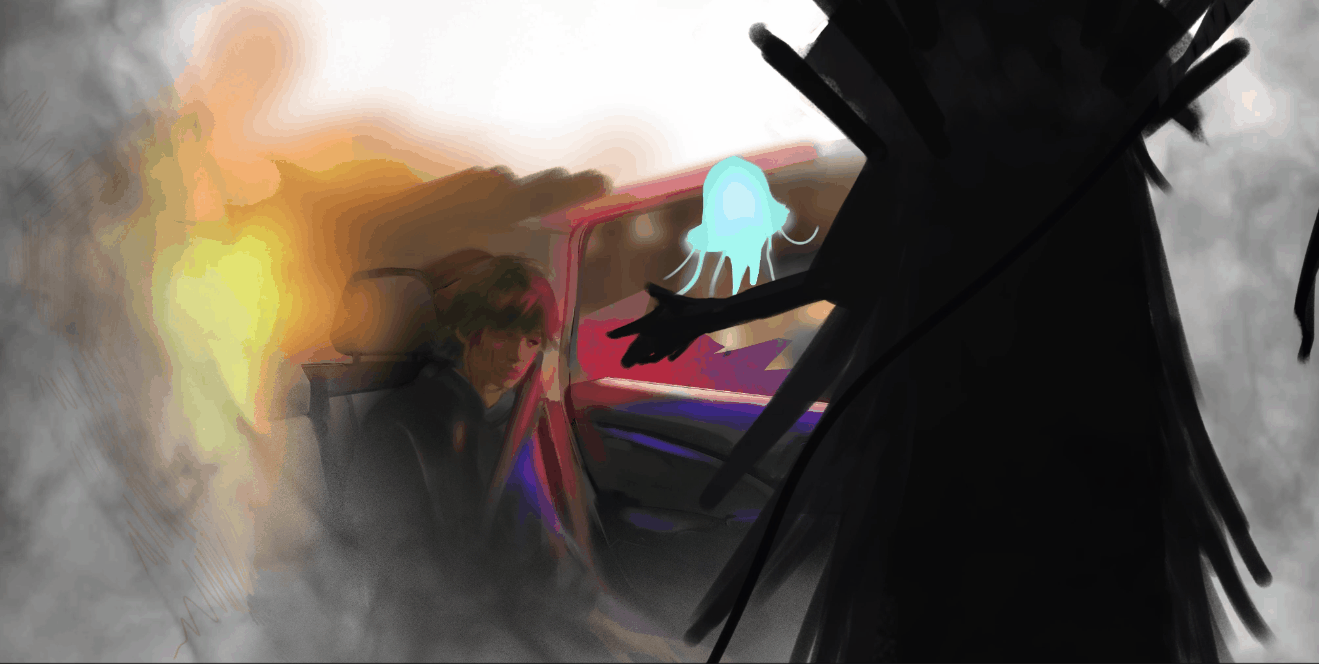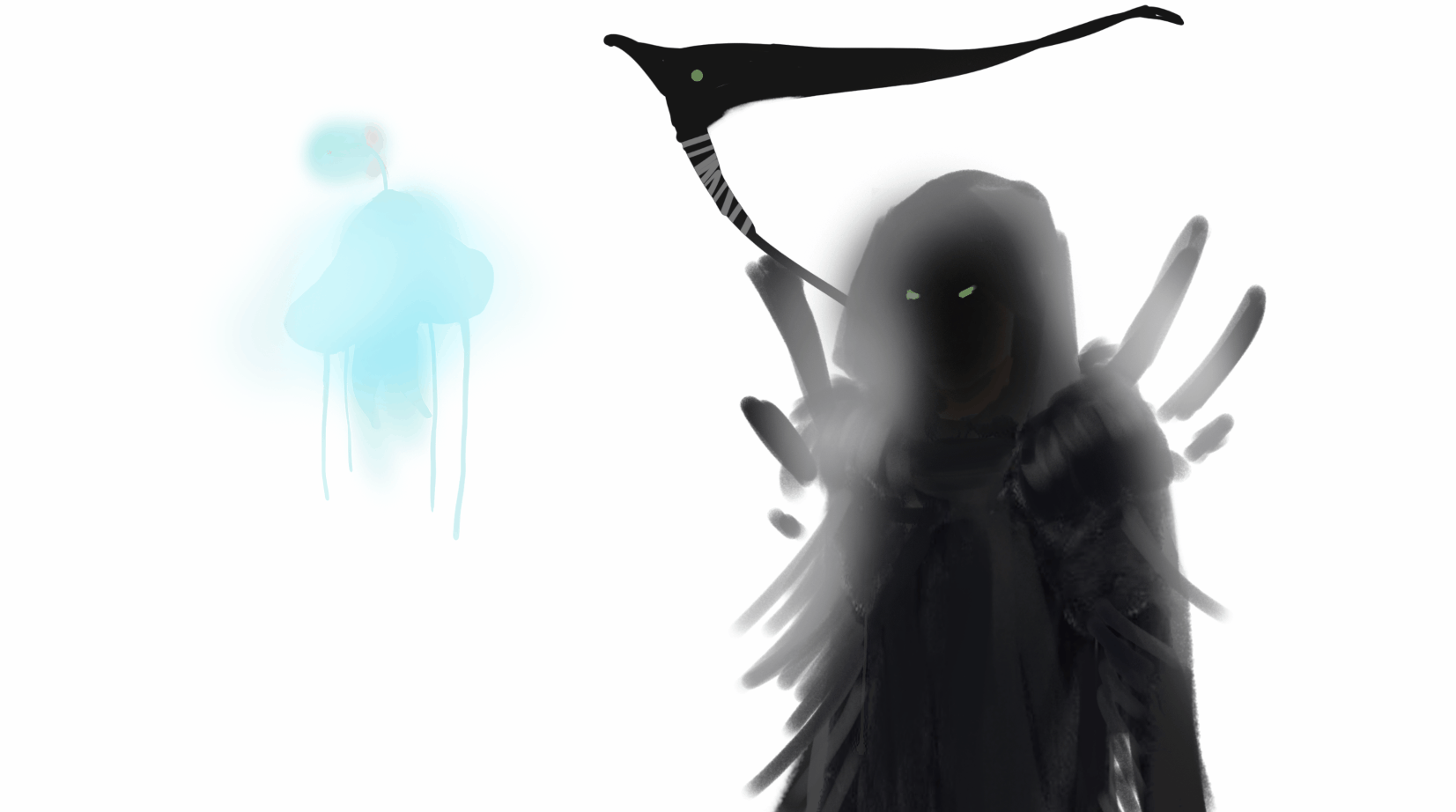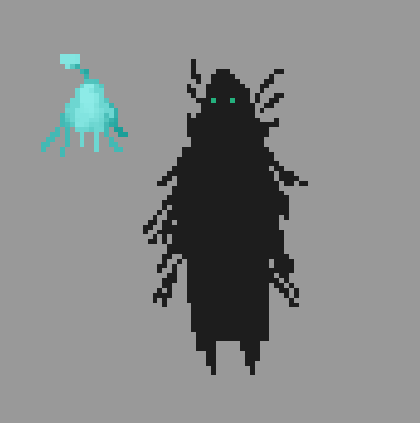Dream
Team: W&T
Role :
Game Designer
Art Lead
Sound Designer
Programmer
Genre: Visual Novel Game
Project Summary
This is a visual novel that tells the story of:
A dutiful Grim Reaper, loyal to his job, who finds himself at a crossroads when he encounters the manifestation of a dream in the form of a small creature.
The narrative explores the relationship between the Grim Reaper and the Dream, unraveling themes of duty, emotion, and self-discovery.
This was a two-person project, created by me and my friend Tamara. Although it was challenging, I see it as an opportunity where I constantly improved throughout the development process. It was my first time taking on multiple roles, which was a significant challenge, but I’m grateful that we supported each other and successfully brought our vision to life.
Tool
-
Twine
-
Photoshop
-
Miro
-
Discord
Procees Work
Design Process:

Based on the character description provided by the narrative designer, I designed the main character—Dream. Dream is a cute spirit, and while designing it, I drew inspiration from mushrooms and jellyfish, incorporating their organic shapes and soft aesthetics to create a visually appealing and whimsical character.
Additionally, I designed the main character, Grim Reaper. To contrast with the traditional depiction of a grim reaper, I incorporated crow feathers into the design, adding a sense of mystery and elegance while reinforcing the character's connection to death and the unknown.


In his past life, the Grim Reaper was a young boy —— Leo, so I designed an initial character concept reflecting this. Since the character has a calm yet rebellious personality, I incorporated elements that highlight his traits, such as headphones, a necklace, and a distinct clothing style, reinforcing his individuality and attitude.
Based on the narrative designer’s input, I initially created a flowchart to outline the story structure and player choices within the game. This helped establish the core narrative flow while ensuring that the player’s decisions were clearly mapped out in the gameplay.
Gameplay Design Process:
Art Process:

For the main menu design, I wanted the composition to reflect the relationship between the Grim Reaper and Leo. To achieve this, I used a divided, opposing composition, subtly hinting at their deep connection while also sparking the player's curiosity.
For the title design, I incorporated Dream’s signature color (blue) by using a striking neon blue, making the title stand out while distinguishing it from the background characters. Additionally, I added Dream’s small tentacle beneath the letter "A," further integrating the character’s presence into the design.
I used After Effects (AE) to animate the hair and scarf in the illustration/cover, making the main menu feel more dynamic and alive. This subtle movement adds a sense of motion and atmosphere, enhancing the overall presentation and immersiveness of the game’s opening screen.

My main inspiration came from the cover design of The Mirage House because it subtly portrays the two main characters and their relationship. I referenced this clever composition in my own design, aiming to similarly convey the dynamic between the Grim Reaper and Leo in a visually compelling way.


In the game, there is a scene where Leo witnesses his parents arguing, so I created two illustrations to portray this moment:
-
One illustration shows Leo gradually becoming silent and withdrawn as he repeatedly sees his parents arguing about money. The shadows in the background depict his parents fighting, subtly indicating that Leo is watching them but feeling powerless.
-
The second illustration is from Leo’s direct perspective, showing his parents arguing as he sees them.
-
When illustrating this, I used a low-angle perspective looking upward, emphasizing that the scene is being viewed from Leo’s point of view. This perspective not only enhances immersion but also conveys the emotional weight of the moment, making players feel the overwhelming presence of his parents' conflict.
-

In the game, Leo’s family experiences a car accident, where his father—who was responsible for supporting the family—tragically passes away.
Since this scene takes place in a dream, I used negative/white space in my illustration, intentionally not fully rendering all the details. Instead, I incorporated misty effects and white voids to create a surreal, dreamlike representation of the accident.
During the color adjustment process, I noticed that the scene featured multiple light sources from different angles, which could easily make the composition feel chaotic. To address this, I lowered the saturation of the main characters, allowing the firelight and the flashing police car lights outside the window to stand out.
For the lighting arrangement:
-
The firelight is positioned in the background, creating depth.
-
The police car’s lights come from the window, providing a stark contrast.
-
The black smoke surrounds the scene, framing the composition and ensuring that the focus remains clear without overwhelming the viewer.
This approach helped maintain visual clarity while enhancing the emotional impact of the scene.

In the game, there is a scene that highlights the bond between the siblings, so I illustrated a moment where the older brother silently watches over his younger sister as she draws.
To emphasize the dreamlike atmosphere, I used a white background, making the characters stand out while reinforcing the surreal nature of the scene. However, since an entirely white background could feel too empty, I added a pencil case in the foreground to anchor the composition and create a sense of space.
Additionally, I included cute, soft visual effects in the background to enhance the feeling of innocence and mutual reliance between the siblings. These small details help to subtly convey their pure and supportive relationship, making the moment feel more heartfelt and emotionally resonant.

In one of the bad endings, the Grim Reaper realizes that he is actually Leo, but he fails to fully save his sister, Dream.
To visually represent this moment, I used a white background to emphasize the emotional weight of the scene and to maintain a dreamlike, surreal atmosphere. The focus is on Leo and Dream gazing at each other, highlighting their connection and the tragic realization.
To enhance the reveal, I created a simple animation where the Grim Reaper’s veil slowly lifts, allowing players to gradually discover that he is actually Leo. This slow revelation builds tension and emotional impact, reinforcing the weight of his unfinished journey.

In another bad ending, the Grim Reaper not only regains his memories but also reunites with his sister, Dream.
To visually portray this moment, I used a top-down perspective, as I felt this angle best emphasizes the intensity of their embrace, making their reunion feel more intimate and emotional.
To enhance the transformation and realization, I created a simple animation where Dream gradually reveals her true form as Ana. This slow reveal adds a sense of mystery and emotional weight, allowing players to fully grasp the depth of their connection and the significance of their reunion.

For the final end menu, I illustrated the main characters—Leo, Ana (Dream), and the Grim Reaper. The goal was to create a farewell moment, where the characters say their final goodbyes to the player, reinforcing the emotional conclusion of the story.
In terms of composition, I centered the Grim Reaper as the focal point, while Leo and Ana were positioned as supporting elements. This layout highlights the Grim Reaper’s significance in the story while still maintaining the presence of the other key characters. The arrangement helps to create a sense of closure, leaving players with a lasting impression of their journey.


Due to the tight production schedule, I used a pixel art style to present the two mid-game endings, ensuring that they could be completed within the limited time frame.
To enhance the storytelling, I also created simple animations, adding movement and emotional impact to these endings while maintaining consistency with the game's overall aesthetic. This approach allowed us to efficiently convey the narrative without compromising quality.
Programming Process:


Using Twine's coding capabilities, I customized the game's font size, color, and selection highlight (set to orange). These adjustments were made through in-game testing and debugging, ensuring that the text remained readable, visually appealing, and thematically consistent with the game's overall aesthetic.
(in-game screenshot)

In our game, we needed to integrate illustrations seamlessly into the narrative flow, so I utilized Twine's "Tag" feature to manage this process efficiently.
By assigning tags to specific scenes, I ensured that the correct illustration would appear automatically whenever needed. For example:
-
I set the background of Dream floating in darkness to the tag "dream".
-
When a scene required this illustration, I simply added the "dream" tag to the corresponding dialogue, allowing Twine to display the correct visual automatically

Sound Design Process:

Finally, I integrated various sound effects and background music into the game. Since Twine does not support direct audio implementation, I had to use custom code to achieve this.